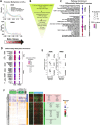Integrative Genomic and Transcriptomic Analysis Reveals Targetable Vulnerabilities in Angioimmunoblastic T-Cell Lymphoma
- PMID: 40510016
- PMCID: PMC12326222
- DOI: 10.1002/ajh.27736
Integrative Genomic and Transcriptomic Analysis Reveals Targetable Vulnerabilities in Angioimmunoblastic T-Cell Lymphoma
Abstract
Nodal follicular helper T-cell (T FH) lymphoma of the angioimmunoblastic (AITL) subtype has a dismal prognosis. Using whole-exome sequencing (n = 124), transcriptomic (n = 78), and methylation (n = 40) analysis, we identified recurrent mutations in known epigenetic drivers (TET2, DNMT3A, IDH2 R172 ) and novel ones (TET3, KMT2D). TET2, IDH2 R172 , DNMT3A co-mutated AITLs had poor prognosis (p < 0.0001). Genes regulating T-cell receptor (TCR) signaling (CD28, PLCG1, VAV1, FYN) or activation (RHOA G17V ) or regulators of the PI3K-pathway (PIK(3)C members, PTEN, PHLPP1, PHLPP2) were mutated. CD28 mutation/fusion was associated with poor prognosis (p = 0.02). WES of purified, neoplastic T-cell (CD3+PD1+) demonstrated high concordance with whole tumor biopsies and validated the presence of TET2 and DNMT3A in tumor and non-lymphoid cells, but other mutations (CD28, RHOA G17V , IDH2 R172 , PLCG1) in neoplastic cells. Integrated DNA-methylation and mRNA expression analysis revealed epigenetic alterations in genes regulating TCR, cytokines, PI3K-signaling, and apoptosis. RNA-seq analysis identified fusion transcripts regulating TCR-activation (8%), revealed a restricted TCR-repertoire (α = 87%, β = 72%), and showed the presence of Epstein-Barr virus transcriptome (73%). GEP demonstrated the association of B-cells or dendritic cells in the tumor milieu with prognosis (p < 0.01). RNA-seq and WES analysis of 12 AITL-patient-derived-xenografts (PDX) showed that bi-allelic TET2 and DNMT3A mutations or sub-clonal mutations (PLCG1, PHLPP2) propagated in sequential passages, and gene signatures related to T FH and T CM (central-memory) were well-maintained through passages. Gene expression signatures associated with late PDX passages (3rd-5th) were enriched with proliferation and metabolic reprogramming-related genes and predicted prognosis in an independent AITL series. Low PHLPP2 mRNA expression predicted poor prognosis (p = 0.05) and engineered PHLPP2 or TET2 loss in CD4+ T-cells showed enhanced PI(3)K activation, thus uncovering a therapeutic target for clinical trials.
Keywords: cancer genetics; genomics and transcriptomics; lymphomaangioimmunoblastic T‐cell lymphoma.
© 2025 The Author(s). American Journal of Hematology published by Wiley Periodicals LLC.
Conflict of interest statement
The authors declare no conflicts of interest.
Figures





References
-
- Mourad N., Mounier N., Briere J., et al., “Clinical, Biologic, and Pathologic Features in 157 Patients With Angioimmunoblastic T‐Cell Lymphoma Treated Within the Groupe D'etude Des Lymphomes de L'adulte (GELA) Trials,” Blood 111, no. 9 (2008): 4463–4470, 10.1182/blood-2007-08-105759. - DOI - PMC - PubMed
-
- Petrich A. M., Helenowski I. B., Bryan L. J., Rozell S. A., Galamaga R., and Nabhan C., “Factors Predicting Survival in Peripheral T‐Cell Lymphoma in the USA: A Population‐Based Analysis of 8802 Patients in the Modern Era,” British Journal of Haematology 168, no. 5 (2015): 708–718, 10.1111/bjh.13202. - DOI - PubMed
MeSH terms
Substances
Grants and funding
- TRP-6129-04/Leukemia and Lymphoma Society, SCOR
- UH3 CA206127/CA/NCI NIH HHS/United States
- P01 CA229100/CA/NCI NIH HHS/United States
- CA206127-02/CA/NCI NIH HHS/United States
- CA229100/CA/NCI NIH HHS/United States
- R41CA221466-01A1/CA/NCI NIH HHS/United States
- 221580/Norges Forskningsråd
- R01 CA251412/CA/NCI NIH HHS/United States
- P30 CA033572/CA/NCI NIH HHS/United States
- UH2 CA206127/CA/NCI NIH HHS/United States
- 218241/Norges Forskningsråd
- P30CA033572/CA/NCI NIH HHS/United States
- R01CA251412/CA/NCI NIH HHS/United States
- R41 CA221466/CA/NCI NIH HHS/United States
LinkOut - more resources
Full Text Sources
Research Materials
Miscellaneous

